Knowledge Center
A sofa is one of the most important purchases for your home. It’s often the main focal point of a living room – the one space in your home which most commonly serves as a place to both relax and entertain, to gather and to spend time in.
Hundreds of books having been dedicated to the history of this furniture stalwart and just as many tributes have been created by design icons from Le Corbusier to Vladimir Kagan. In fact, often a sofa can be representative of an entire style period – Modernist, Art Deco or Victorian – at first sight. With such a detailed past, understanding the distinction between and choosing sofa styles can prove difficult. It may have been deconstructed and reimagined, undone and redone in everything from metal to cardboard but, truth be told, the classics are always in fashion. Discover the 12 sofa styles you need to know about.
1. KNOLE SOFA
17TH CENTURY
A descendant of the original 17th century sofa (which can still be found in Knole House in Kent, England), the knole sofa is one which has been admired by furniture fans for its unique look. Characterised by its arms which are actually sides which drop down like leaves, it was originally designed as a throne-like sofa for the monarch.
The version shown here is a little more traditional with finials, corded ties and fringe in tact but these elements are often forgone for a modern interpretation.
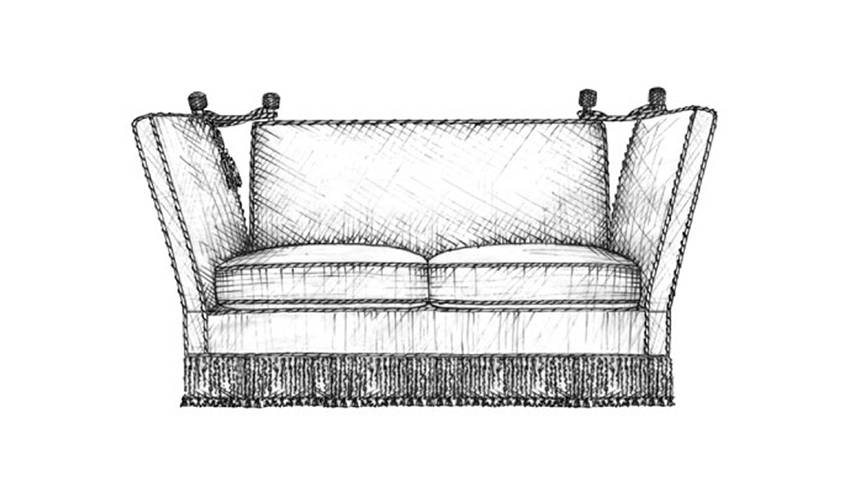
Illustrations by Anara Mambetova-Finkelstein from The Pattern Book of Upholstery (Bauer and Dean Publishers)
2. LOUIS XV SETTEE
18TH CENTURY
Timeless and refined, the Louis XV settee is a delicate piece to include in an interior, particularly for classical or classic contemporary spaces. Its elegance and grandeur are thanks to its exposed wood frame (a standout feature which is visually lighter), intricate carvings and arm pads. Sinuous lines and shell carvings set the style apart from the earlier Louis XIV designs.
Upholstered in a traditional brocade or damask, the result is one of rich opulence but a neutral linen or modern velvet is equally chic. Nailhead trim was a common choice of original designs but piping is frequently used nowadays.
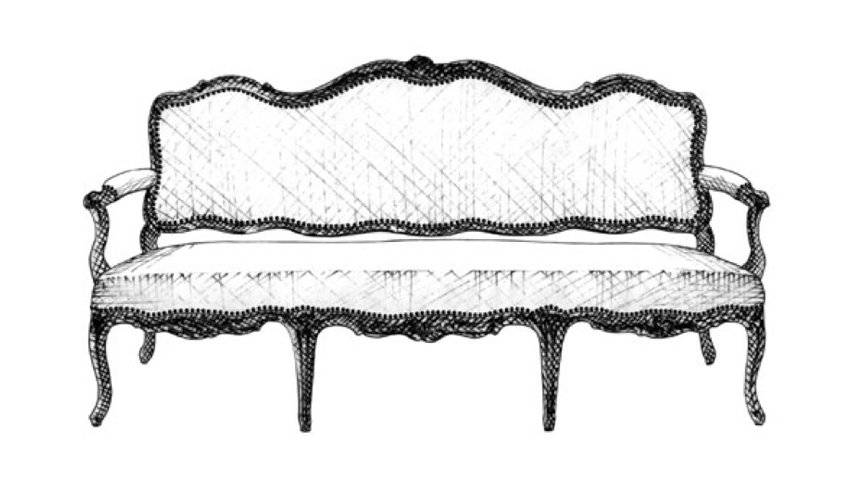
Illustrations by Anara Mambetova-Finkelstein from The Pattern Book of Upholstery (Bauer and Dean Publishers)
3. LOUIS XV CANAPÉ
18TH CENTURY
Also described as a baguette-shaped canapé, the Louis XV canapé is, like the settee, defined by its grand Rococo design. Again, notable for an exposed wooden frame, this design uses an enveloping shape which curves at the ends, merging the backrest with the sloped arms in one unbroken silhouette. The back is not only upholstered on the inside but on the outside, also, which creates a sense of luxury as the rich wood is contrasted with opulent upholstery.
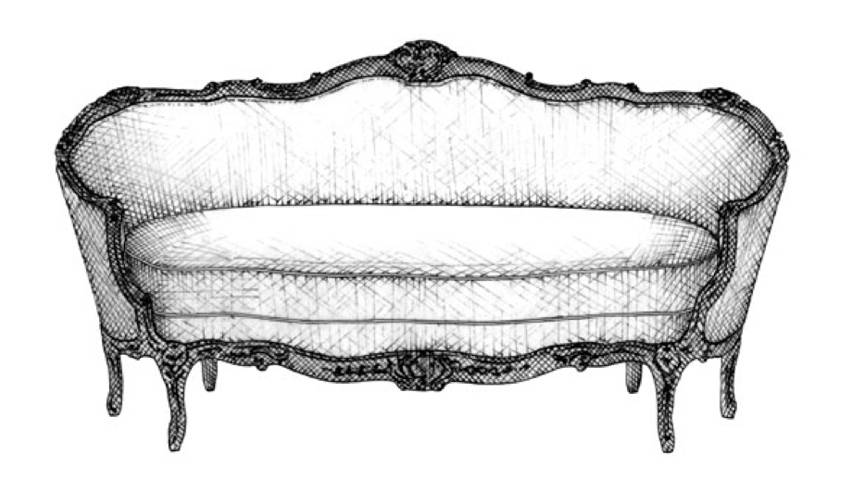
Louis XV baguette sofa
Illustrations by Anara Mambetova-Finkelstein from The Pattern Book of Upholstery (Bauer and Dean Publishers)
4. CAMELBACK SOFA
ORIGINAL 18TH CENTURY; SHOWN HERE 20TH CENTURY
The appropriately named sofa was a style born of the 18th century made famous by master furniture designer Thomas Chippendale. The original design was distinguished by fitted scroll arms and a wooden carved base complete with cabriole legs and scroll or ball-and-claw feet. The sofa can feature one backrest hump or two and can be subtly shaped or more pronounced.
This modern version takes the traditional feature and sharpens it with the addition of bracket accents, loose seat cushion and sloped arm.
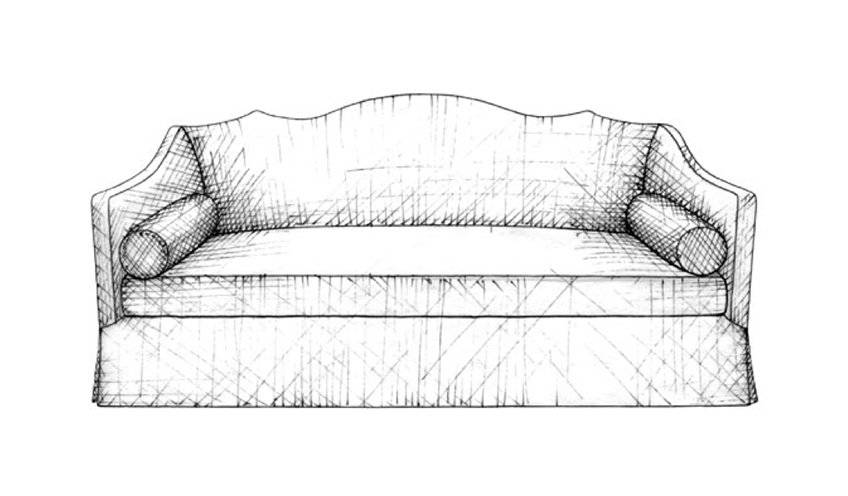 Illustrations by Anara Mambetova-Finkelstein from The Pattern Book of Upholstery (Bauer and Dean Publishers)
Illustrations by Anara Mambetova-Finkelstein from The Pattern Book of Upholstery (Bauer and Dean Publishers)
5. ENGLISH CLUB SOFA
20TH CENTURY
The club sofa is a classic of traditional British interiors with its pleated, rolled arms set back from the front of the seat, turned wooden legs on casters and softened lines. Casual yet sophisticated, its two seat cushions and a split backrest add to its heritage appeal.
The club is particularly well suited to traditional and country settings and offers a quaint aesthetic especially when enhanced with a charming fabric. A beautiful block colour linen sits well in a coastal environment and a plush velvet gives it an unexpected luxury.
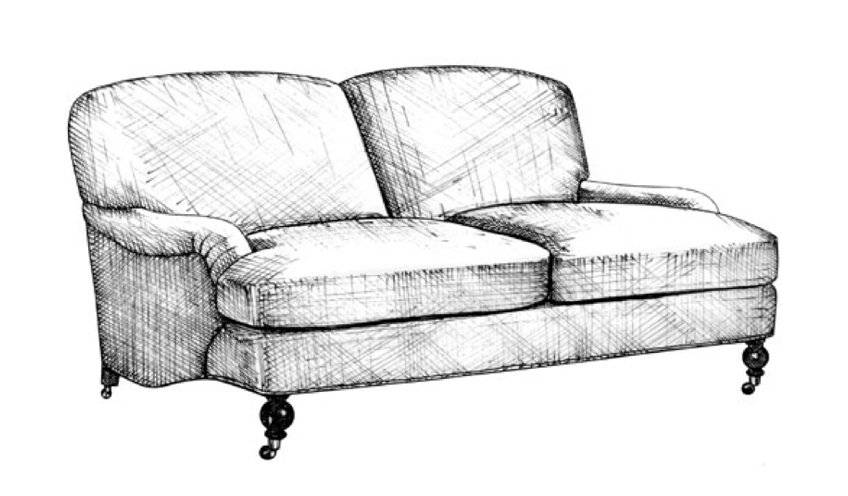
Illustrations by Anara Mambetova-Finkelstein from The Pattern Book of Upholstery (Bauer and Dean Publishers)
6. CHESTERFIELD SOFA
18TH CENTURY
Ask anyone to name a sofa style and, chances are, they’d name a Chesterfield. Such is the power of the design – in fact, in certain parts of North America the term has become a synonym for sofa. It denotes a deeply button-tufted leather sofa with even-height arms and backrest which are tightly rolled and accented with nailhead trim.
The iconic design is of 18th century origin but apparently its recognisable modern-day counterpart wasn’t around until it was commissioned by Phillips Stanhope, 4th Earl of Chesterfield, in the early 1900s. Nowadays, the sofa is often upholstered in materials other than leather which gives it a comfortable appeal.
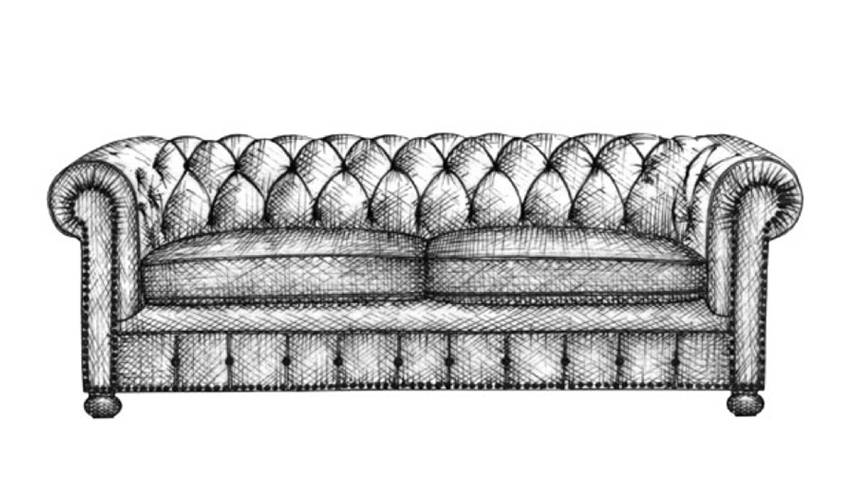
Illustrations by Anara Mambetova-Finkelstein from The Pattern Book of Upholstery (Bauer and Dean Publishers)
7. LOVE SEAT
18TH CENTURY
Ideal for a smaller space, a love seat is a sofa which can seat two sitters. Despite its name, reports suggest that it was originally designed in the 18th century to permit ladies of the time to sit comfortably whilst dressed in their ample gowns.
Here, the love seat is shown in a modern incarnation with simple legs and a single seat cushion, however, oftentimes the style features two seat cushions and has more of a traditional sofa shape.
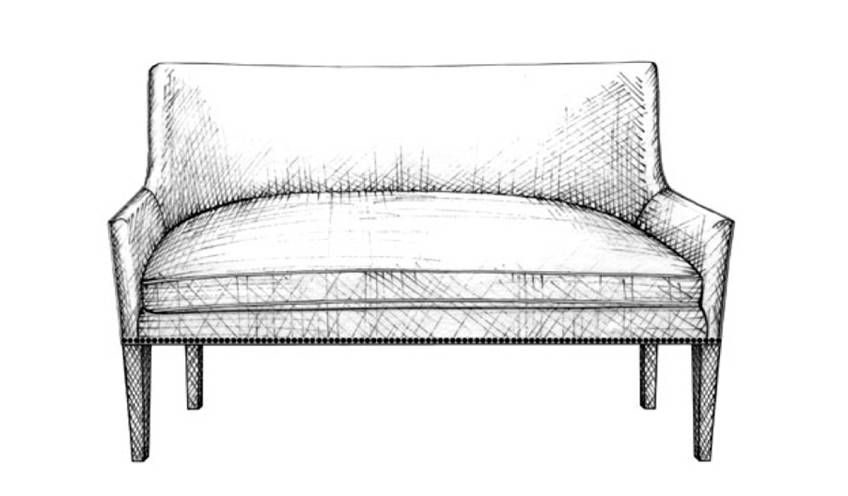
Illustrations by Anara Mambetova-Finkelstein from The Pattern Book of Upholstery (Bauer and Dean Publishers)
8. ART DECO SOFA
20TH CENTURY
This sofa is a fine example of Art Deco’s use of curved lines and flattened planes. Piped edges keep the style crisp whilst its simple block feet are significant of the movement’s divergence from ornamental to streamlined motifs.
Again, this is a statement sofa which is best used in a formal space – probably not suitable for a space destined for lounging. Due to its curved ends, a sofa like this does require a larger footprint so this should be borne in mind when arranging a furniture arrangement.
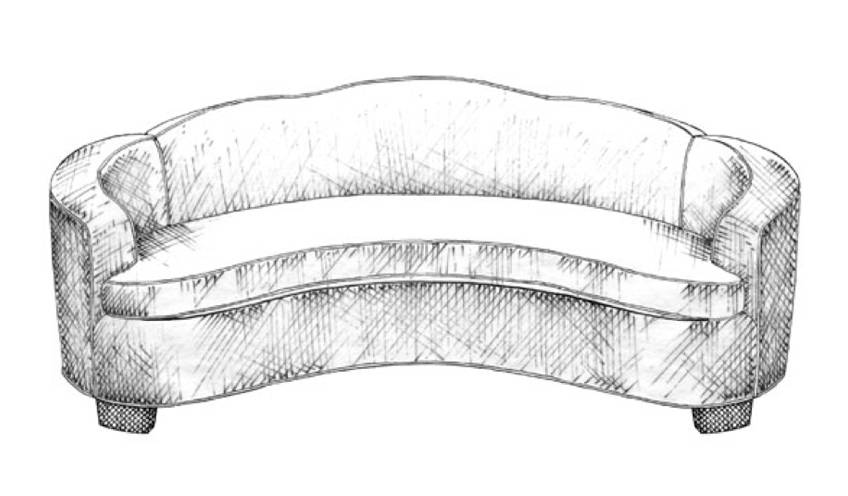
Illustrations by Anara Mambetova-Finkelstein from The Pattern Book of Upholstery (Bauer and Dean Publishers)
9. MIDCENTURY MODERN SOFA
20TH CENTURY
This design (represented here in a circa 1950 Edward Wormley design) has become a favourite in recent years. Midcentury Modern (like its antecedent, the game-changing Modernist movement) replaced traditional ornamentation for streamlined shapes.
Loved for their playful but forward-thinking style, Midcentury sofas are recognisable by shallow button tufting (often a precise, single row), blocky silhouette and simple frame. The addition of bolster end cushions gives it that identifiable retro aesthetic.
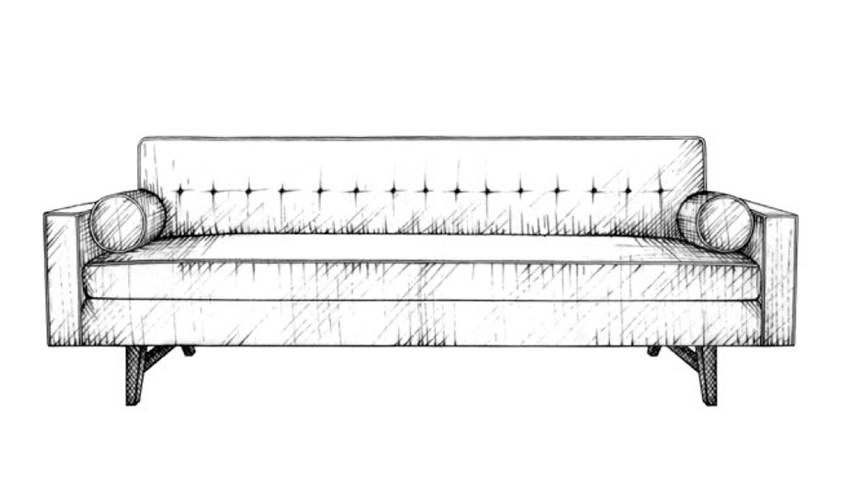
Midcentury Modern sofa
Illustrations by Anara Mambetova-Finkelstein from The Pattern Book of Upholstery (Bauer and Dean Publishers)
10. LAWSON SOFA
20TH CENTURY
Fitted, scroll arms, plush cushions and masses of space make the Lawson sofa a comfortable addition to a room. Its generous proportions make it ideal for lounging and its smart-casual look is preferred by many homeowners.
Shown here, the design is imagined with a three-part fitted back and loose seat cushions. A kick-pleat skirt is often included for a rustic feel but this design opts for a simple block foot. Metal sabots are an easy way to add luxury to this staple.
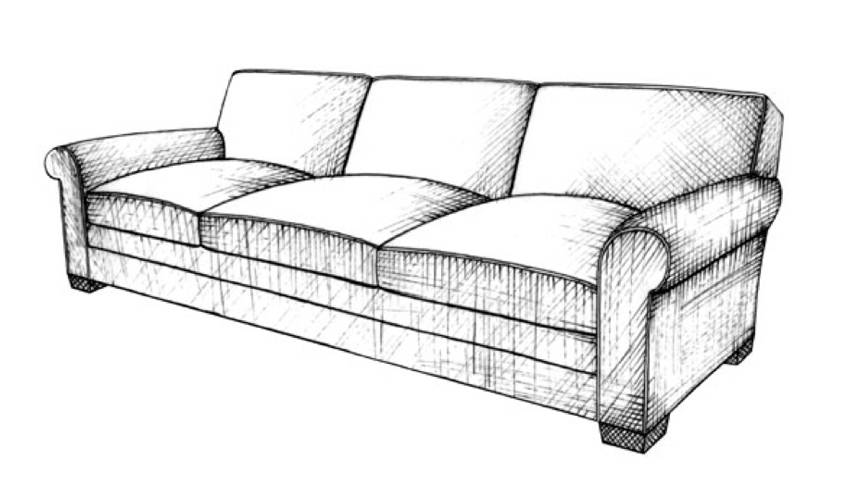
Illustrations by Anara Mambetova-Finkelstein from The Pattern Book of Upholstery (Bauer and Dean Publishers)
11. TUXEDO SOFA
20TH CENTURY
With its fitted, square and even-height arm and backrests, a tuxedo is an eternally sophisticated silhouette and the equivalent of a tailored suit to the furniture world. Even the nailhead trim (shown here although this isn’t a necessity) reinforces the sharp lines.
Proportions and precise upholstery are everything and give it the refined appeal it has become known for. Characterised by clean lines, the style is one of the slickest you could choose and instead of drawing attention due to elaborate features, it draws attention thanks to its strong visual aesthetic.
Its inherently structured form encourages the sitter to sit upright making it perfect for a formal furniture arrangement.
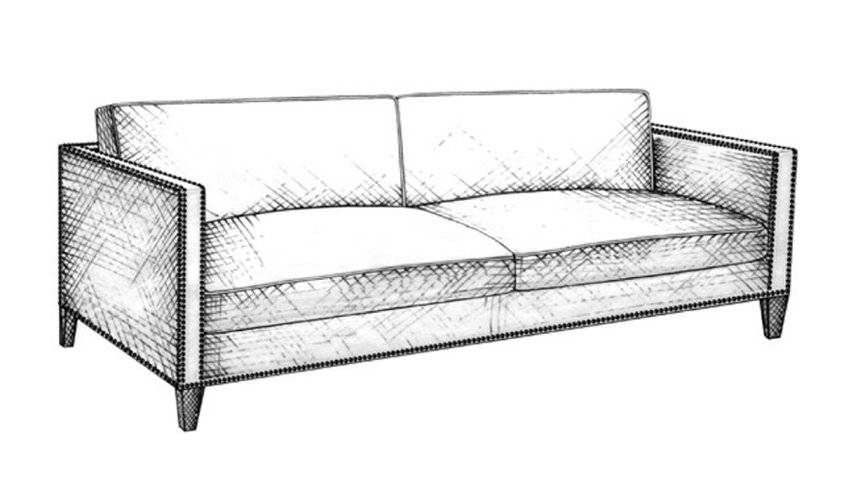
Illustrations by Anara Mambetova-Finkelstein from The Pattern Book of Upholstery (Bauer and Dean Publishers)
12. SECTIONAL SOFA
20TH CENTURY
A sectional is a mainstay of modern interiors which was designed not only for comfort but for flexibility. Thanks to literally thousands of configurations due to its interdependent, individual components, the style can be customised to suit any space.
Consisting of at least two sections, a sectional sofa’s elements are placed together to elongate and wrap around a corner usually with a minimum of a 90 degree join. Chaise longs and closed-end pieces can also be included (unlike this open-ended design) to keep the design self-contained. A barely-there structure (which usually means slender metal legs) are one of the sofa’s defining feature.
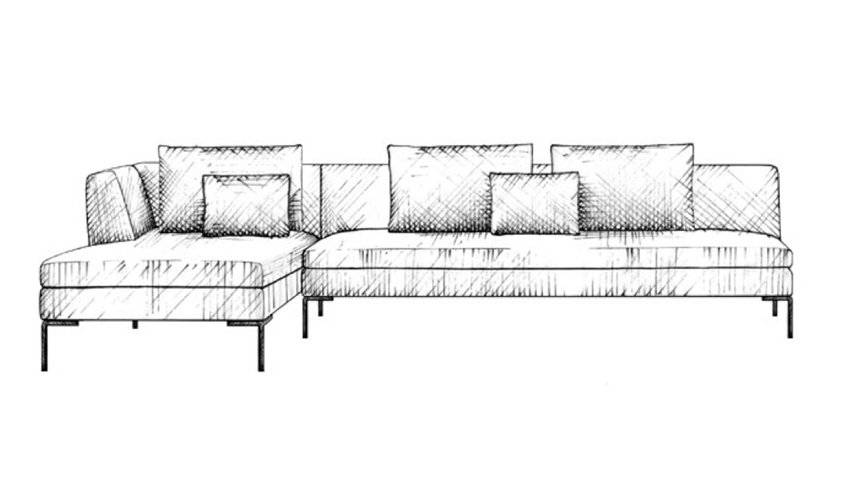 Illustrations by Anara Mambetova-Finkelstein from The Pattern Book of Upholstery (Bauer and Dean Publishers)
Illustrations by Anara Mambetova-Finkelstein from The Pattern Book of Upholstery (Bauer and Dean Publishers)
Source: luxdeco.com